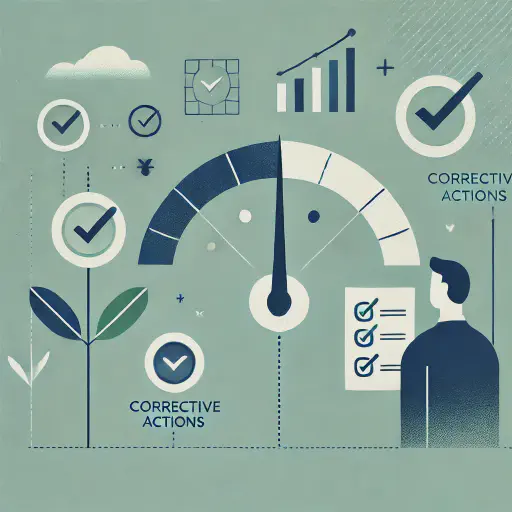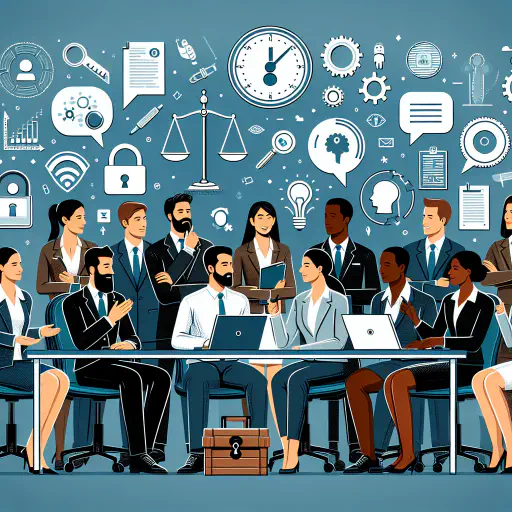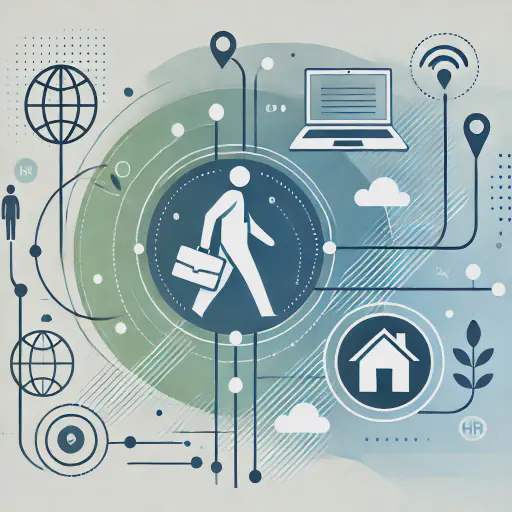
Boosting Morale: Employee Engagement Activities That Make a Difference
Embarking on a path to enhance employee involvement doesn’t have to be complex. This guide offers straightforward strategies to revitalize your team’s engagement. By applying these techniques, you’ll not only see a boost in performance but also cultivate a culture where each member is an appreciated contributor.
Have you ever walked into an office and been met with silence that speaks volumes about the team’s disengagement? Such silence can be indicative of low morale, a pervasive issue that drains energy and hampers productivity. Addressing this concern is vital to build a supportive atmosphere where employees can thrive, ultimately benefiting the entire organization.
In this guide, we’ll share actionable steps to engage your team effectively. By embracing these recommendations, you can expect to see improved teamwork, increased productivity, and a more attractive workplace for top talent—all key factors in driving your company’s success.
1. Personalized Recognition Programs
To truly value employees and boost their morale, companies should personalize recognition programs. This involves tracking individual achievements for timely and meaningful rewards. An internal platform can facilitate nominations and allow for tailored rewards. These rewards could be extra vacation days, event tickets, or company newsletter features. Understanding employees’ preferences ensures these rewards resonate and are genuinely appreciated.
Implementing a System for Tracking Achievements
Understanding employees’ unique contributions is key to boosting morale. Implement a tracking system, maybe through an internal platform, where achievements are recognized in real-time. Celebrate milestones with rewards that reflect the individual’s interests. Perhaps use surveys to collect data on what they value most.
Encouraging Peer-to-Peer Recognition
Peer recognition is a powerful motivator. Encourage employees to nominate their colleagues for awards, perhaps through a simple online nomination process. This not only uplifts the recipient but also fosters a culture of appreciation and community within the workplace.
Offering Tailored Rewards
Rewards should not be one-size-fits-all. Offer choices like extra time off, concert tickets, or public recognition in a company newsletter, based on the employee’s interests. Personalizing rewards shows that the company pays attention to individual preferences, making the recognition feel more sincere.
Regularly Updating and Communicating the Recognition Program
Keep the recognition program fresh and in the forefront of employees’ minds by regularly updating the rewards and communicating the successes. Highlighting winners in a company meeting or email can reinforce the importance of the program and keep engagement high.
2. Fostering Professional Growth to Boost Morale
Professional growth opportunities are a cornerstone of employee engagement. Offering a variety of development options, such as in-house training, external workshops, and educational reimbursement, encourages career progression. Mentorship programs further support growth, with mentors providing invaluable guidance. Allowing time for these activities during work hours shows the company’s commitment to its employees’ professional journeys.
Tailored In-House Training Programs
Tailored in-house training programs signal a company’s investment in its employees’ specific skills and career paths. By utilizing internal resources and expertise, organizations can create a personalized learning environment that caters to the diverse needs of their workforce.
For instance, a well-executed training session by a seasoned team member not only upskills colleagues but also fosters a sense of community and shared knowledge.
External Workshops and Seminars
Attending external workshops and seminars exposes employees to new ideas and industry standards, broadening their horizons. Companies that support participation in these events demonstrate their commitment to continuous learning.
For example, sponsoring an employee’s attendance at a conference can be a transformative experience, offering them fresh insights and networking opportunities that can be brought back to benefit the entire team.
Educational Reimbursement Programs
Offering tuition reimbursement for continued education conveys a message that the company values long-term employee growth. This initiative can lead to higher job satisfaction and retention rates. An employee who has been reimbursed for a course related to their work is likely to feel more engaged and grateful, translating to increased loyalty and productivity.
Structured Mentorship Programs
A structured mentorship program pairs less experienced employees with seasoned professionals, facilitating a transfer of knowledge and experience. Such programs can be a platform for personal and professional development, creating a nurturing environment that benefits mentors and mentees alike.
A mentor’s guidance can help navigate career paths and elevate the mentee’s confidence and skills.
Allocating Time for Growth Activities
By allocating time for professional development activities within working hours, a company shows practical support for employee growth. This approach encourages participation by removing barriers, such as time constraints, that might otherwise prevent employees from engaging in development opportunities. It also sends a clear message that the company prioritizes the advancement of its employees.
3. Flexible Work Arrangements
Flexible work arrangements are a significant factor in employee satisfaction and retention, enabling a healthier work-life balance. Companies should assess job roles to identify flexibility options, establish clear guidelines for remote work, and invest in collaboration technologies. Fair policies and communication are key in these arrangements to ensure accountability and support.
Assessing Job Role Flexibility
Assess each role within your organization to determine the potential for flexible hours or remote work. For example, if data analysis shows that certain tasks can be done effectively outside traditional office hours, consider allowing employees to adjust their schedules accordingly. This practical approach demonstrates your company’s commitment to accommodating individual needs.
Developing Clear Remote Work Policies
Craft clear and fair remote work policies that outline expectations for communication, availability, and deliverables. Use real-life examples to illustrate successful remote work scenarios, and be transparent about the guidelines.
This clarity helps employees feel secure in their roles and responsibilities, no matter where they are working from.
Investing in Collaboration Technology
Invest in reliable technology that facilitates remote collaboration and maintains team connectivity. Highlighting case studies of other businesses that have successfully implemented such technologies can offer inspiration and confidence in these tools.
This investment not only supports flexible work but also encourages innovation and teamwork across distances.
Promoting Fairness and Communication
Ensure fairness in flexible work arrangements with regular check-ins and open communication channels. Share testimonials from employees who have experienced positive changes in their work-life balance thanks to these policies.
This transparency builds trust and shows that management values and respects its employees’ time and contributions.
4. Enhancing Team Cohesion with Interactive Activities
Team cohesion and morale are critical to employee engagement, and interactive team-building activities can make a significant impact. Regularly scheduled events that require collaboration can range from physical challenges to community service and idea-generating hackathons. It’s essential to consider everyone’s interests and abilities, and having a dedicated committee to organize these activities ensures diversity and inclusion in event planning.
Diversity in Team-Building Events
A rating of 9 points to this subpoint indicates its high value. Diversity in team-building events ensures that activities appeal to a broad spectrum of interests and abilities. For example, mixing up activities between physical challenges, creative contests, and community service not only caters to different preferences but also fosters a sense of unity in celebrating diverse talents. Sharing anecdotes from past successful events can inspire participation and enthusiasm.
Committee-Driven Event Planning
With an 8-point rating, involving a committee in event planning is invaluable. A committee reflective of the company’s diversity can curate a well-rounded calendar of events. This hands-on approach can humanize the planning process, as committee members share their stories and motivations for selecting certain activities, making the events more relatable and engaging for all employees.
Inclusivity in Team Dynamics
Scoring 7 points, ensuring inclusivity within team dynamics is crucial. When organizing team-building activities, it’s important to consider the physical abilities and comfort levels of all employees. Featuring testimonials from employees who felt included and valued in such events can encourage others to participate, highlighting the positive impact on team cohesion and morale.
5. Open Communication Channels
Cultivating an environment of open communication is critical for employee morale and engagement. Companies should foster regular dialogues across all levels, where updates, challenges, and feedback are openly discussed. Utilizing digital forums and suggestion boxes encourages anonymous and honest feedback. The key is to act on suggestions and communicate changes, demonstrating that employee contributions are valued and impactful.
Regular Feedback Meetings
Rating: 9
Regular feedback meetings can be the cornerstone of effective communication. By scheduling consistent sessions where employees can voice concerns and ideas, you create a transparent atmosphere. An example that illustrates the power of these meetings is the “town hall” format used by many successful organizations, where executives address the entire company and take questions. This approach breaks down hierarchical barriers and fosters a sense of community.
Anonymous Suggestion Systems
Rating: 8
An anonymous suggestion system can be instrumental in understanding the unfiltered perspective of employees. Incorporating testimonials or success stories of implemented suggestions can showcase the system’s effectiveness. For example, a simple idea from an anonymous suggestion box that led to a significant operational improvement can inspire others to contribute their ideas, knowing that their voice can make a difference.
Action and Transparency
Rating: 7
When employees see their suggestions come to fruition, it validates their participation in the communication process. Utilizing data and statistics to demonstrate how feedback led to improvements can be particularly compelling. For instance, sharing before-and-after metrics of a process change initiated by employee feedback can highlight the tangible impact of open communication channels.
Creating a workplace where employees feel comfortable sharing their thoughts and ideas is crucial for boosting morale and engagement. To facilitate this, regular feedback meetings should be organized, allowing for a transparent and inclusive environment. Additionally, anonymous suggestion systems can encourage honest feedback, with the implementation of ideas reinforcing the value of employee input. Lastly, action and transparency about changes made based on feedback can demonstrate the company’s responsiveness and respect for its employees’ contributions.
6. Wellness Initiatives
Wellness initiatives are a testament to a company’s investment in the overall health and well-being of its employees. These programs can be customized to meet the diverse wellness needs of the workforce, from fitness classes and mental health resources to ergonomic workplace assessments. Partnerships with local gyms or wellness providers can extend the benefits even further. Regular surveys are essential to keep a pulse on employee preferences, ensuring that the initiatives are as beneficial and relevant as possible.
On-site Fitness Classes
Offering on-site fitness classes is a fantastic way to encourage physical activity among employees during the workday. This not only provides convenience but also fosters a sense of community as colleagues come together to exercise. Companies might bring in instructors for yoga, pilates, or circuit training, transforming a conference room into a temporary studio. Such initiatives can lead to improved health outcomes and contribute to a more vibrant, energetic workplace atmosphere.
Mental Health Resources
Mental health resources such as counseling services, stress management workshops, or mindfulness sessions can significantly enhance employee well-being. Some companies have introduced “Mental Health Days” that employees can take without explanation, similar to a sick day. Promoting open discussion about mental health can help destigmatize these issues and create a more supportive environment.
Ergonomic Workplace Assessments
Ergonomic assessments are critical in preventing workplace injuries and improving comfort, especially for those in desk jobs. An expert might be brought in to evaluate workstations and recommend adjustments or ergonomic equipment. Even simple changes, like an ergonomic chair or a standing desk, can significantly improve an employee’s comfort and productivity.
Partnerships with Wellness Providers
By collaborating with local gyms or wellness providers, companies can offer employees discounted memberships or special services. An agreement with a nearby gym, for instance, could provide employees with reduced membership fees, encouraging them to maintain their fitness outside of work. These partnerships add an extra layer of value to the company’s wellness initiatives.
Regular Wellness Surveys
To ensure wellness programs accurately meet employee needs, regular check-ins are crucial. Surveys can collect feedback on existing initiatives and gather suggestions for new ones. This feedback enables the continuous adaptation and evolution of wellness offerings to better match the workforce’s needs and desires.
7. Inclusive Culture Committees
Inclusive Culture Committees are crucial for fostering a diverse workplace where every employee feels included and valued. These committees should be comprised of a diverse group of employees who are passionate about diversity and inclusion. They are tasked with organizing events, facilitating training, and acting as a bridge between the workforce and management on issues of diversity. To ensure these efforts are effective, it’s important to regularly assess the workplace culture and seek external expertise when necessary.
Selection of Diverse Committee Members
Selecting a diverse group of employees for the Inclusive Culture Committee is fundamental. By ensuring representation from various demographics, the committee can better understand and address the unique needs and perspectives within the company.
A story that stands out is when a tech firm expanded their committee to include remote workers, which led to more inclusive decision-making and a 20% increase in remote employee satisfaction.
Organizing Diverse Events
Organizing events that celebrate different cultures, lifestyles, and perspectives is key to promoting inclusivity. For instance, a company that holds monthly cultural heritage celebrations sees a marked improvement in team cohesion. These events not only educate but also allow employees to share their traditions, creating a more connected and understanding workforce.
Facilitating Inclusive Training
Providing training on topics like unconscious bias and cultural competence is extremely valuable. A quote from a diversity expert, “Inclusivity training turns bystanders into allies,” highlights the importance. These sessions can transform the company culture by empowering employees to recognize and challenge discriminatory behaviors, fostering a more supportive work environment.
Regular Assessment and External Expertise
Regularly evaluating the effectiveness of diversity initiatives ensures that the committee’s efforts are aligned with the company’s goals and employee needs. Bringing in external consultants can provide a fresh perspective and specialized knowledge. A case study from a leading consultancy showed that external audits led to a 30% improvement in diversity outcomes for a multinational corporation.
Acting as a Liaison for Diversity Issues
The committee should act as a liaison, providing a safe space for employees to voice concerns and suggestions related to diversity. By acting on this feedback, the company demonstrates its commitment to inclusivity. Personal reflections from committee members about the positive changes they’ve witnessed can inspire confidence and trust among the workforce.
8. Empowerment Through Autonomy
Empowering employees through autonomy can lead to a more engaged workforce, fostering a proactive company culture. A clear definition of autonomy limits and necessary training for decision-making skills are essential. Encouraging initiative and viewing mistakes as learning opportunities are also key. Supportive check-ins can reinforce employee confidence while tackling new responsibilities.
Valuable Decision-Making Training
Enhancing decision-making skills is crucial for employee autonomy. For instance, Zappos, known for its empowering workplace, provides extensive training that allows staff to make customer-focused decisions without managerial oversight.
Similar strategies involve workshops and real-life simulations that prepare employees to handle various scenarios, boosting their confidence and decision-making prowess.
Culture of Initiative and Innovation
A culture that rewards initiative and views failures as learning opportunities can significantly boost morale. Google’s famous ‘20% time’ allowed employees to pursue innovative projects, leading to successful ventures such as Gmail.
Emphasizing a culture where taking calculated risks is celebrated not only drives innovation but also reinforces employee self-worth.
Regular Support and Check-Ins
Regular check-ins offer necessary guidance and support to employees exercising autonomy. Adobe’s ‘Check-In’ system replaced annual reviews with ongoing discussions, enhancing communication and providing immediate feedback that helps employees align their initiatives with company goals.
Such systems can be a safety net, ensuring that while employees navigate new responsibilities, they remain on track and supported.
Empowering employees by granting them autonomy enhances engagement and encourages a proactive attitude. By defining the boundaries of autonomy, providing decision-making training, and fostering a culture that rewards initiative, employees feel both trusted and supported. Regular check-ins ensure they are guided and aligned with the company’s objectives. These strategies collectively create a dynamic workplace where each individual’s sense of responsibility and innovation can flourish.
9. Social Responsibility Programs
Social Responsibility Programs not only enhance a company’s image but also foster a sense of accomplishment and pride among its workforce. Identifying causes that align with both the company’s core values and the passions of its employees is essential for the successful implementation of these programs. Participation through volunteer days, fundraising events, and activities that benefit the community can have a profound impact. Moreover, being transparent about the outcomes of these programs is crucial to deepening employee engagement and their commitment to the company’s social initiatives.
Aligning with Company Values and Employee Passions
To truly connect with your team, choose causes that mirror the essence of your company and resonate deeply with your team members. For example, if your company prioritizes environmental sustainability, consider organizing an event such as a tree-planting day. When employees witness their labor contributing to values they hold dear, they experience an increased sense of purpose and connection. It’s important to remember that genuine engagement is rooted in authentic commitment.
Volunteer Days and Fundraising
Providing paid volunteer days is an influential approach to promoting community participation. It allows employees to invest their time into causes, which can feel more impactful than merely making a financial contribution. Additionally, hosting fundraising activities like charity runs or auctions can enhance team morale and foster a collective sense of accomplishment among the staff.
Transparency and Impact Communication
It’s important to keep your team informed about the differences their efforts are making. Regularly share updates that include stories and statistics about the effects of your social responsibility initiatives. This practice not only affirms the importance of their contributions but also fortifies the trust in the company’s dedication to its social commitments.
10. Gamification of Work Goals
Gamification in the workplace transforms reaching work objectives into a more engaging and enjoyable experience. By identifying key performance indicators suited for gamification, companies can create a system where employees earn rewards and recognition through leaderboards, point systems, or badges. Celebrating achievements keeps motivation high, and a fair, inclusive approach ensures everyone stays engaged and driven.
Identifying Key Performance Indicators (KPIs)
To effectively gamify work goals, it’s crucial to identify which KPIs are most impactful and suitable for gamification. This requires an understanding of the business’s strategic objectives and the behaviors that drive success. For instance, a sales team might focus on the number of client calls made, while a customer service department might track resolution times.
Designing a Reward System
A well-thought-out reward system can make gamification exciting. This might include offering tangible rewards, such as gift cards or extra time off, or recognition-based rewards like employee of the month. The key is to ensure that rewards are desirable and attainable, fostering a sense of achievement.
Ensuring Fairness and Inclusivity
To maintain morale, the gamification system must be fair and inclusive. This means setting clear rules and ensuring that all employees have an equal opportunity to participate and succeed. Regular audits of the system can help identify and eliminate any biases or barriers to participation.
Regular Updates and Celebrations
Keeping the workforce informed with regular updates on gamification standings can sustain engagement. Celebrating milestones and achievements, whether big or small, helps build a positive workplace culture. These celebrations can be as simple as a shout-out in a team meeting or as elaborate as an awards ceremony.
Technology and Tools
The right technology can make or break a gamification strategy. Investing in user-friendly platforms that integrate seamlessly with existing systems will encourage participation. These tools should provide real-time feedback and be accessible to all employees, regardless of their location or role. As we’ve explored the dynamic world of gamification, it’s clear that it’s more than just a trend—it’s a powerful tool for boosting employee morale and engagement. But understanding these strategies is only the beginning.
Now, I challenge you to take the first step in transforming your workplace. Identify one key performance indicator within your team or company that could benefit from gamification. Start small—perhaps with a simple recognition system or a weekly challenge. It’s the immediate actions that catalyze change.
So, set your sights on making work more enjoyable and rewarding for everyone involved. Can you rise to the occasion and gamify one aspect of your work this week? The impact could be more significant than you imagine.





